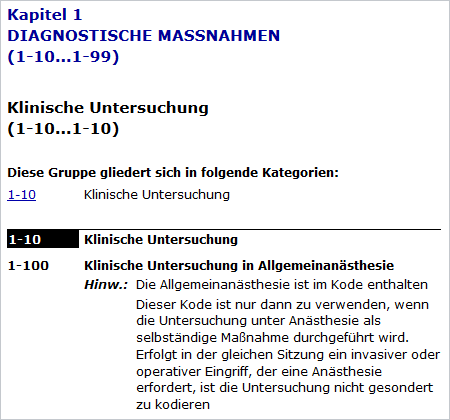Structure of Tabular list
OPS is an interdisciplinary monohierarchical alphanumeric classification for operations and procedures with up to 6 hierarchical levels. The following information is provided for an initial understanding of the OPS. Encoding requires full familiarity with the "Hinweise zur Benutzung" (Notes on how to use OPS) in the preface and - for encoding for billing purposes in the inpatient sector - the application of the German Coding Guidelines DKR and DKR-Psych ("Kodierrichtlinien") of the self-governing partners.
Chapter structure
The Tabular List of OPS in its current version comprises six chapters (1, 3, 5, 6, 8 and 9) covering the range of all encodable medical measures. For historical reasons (reference to ICPM), there are gaps in the chapter numbers. Furthermore, not all four-charcter codes within the chapters are used; the gaps allow for future expansions.
Chapter 5 "Operationen" (Surgical operations) is structured topographically-anatomically; procedures can thus be found in the chapter on the respective organ. The other chapters are structured according to the procedures.
| Chapter | Code-Range | Class title |
|---|---|---|
| 1 | 1-00... 1-99 | Diagnostische Maßnahmen (Procedures for medical diagnosis) |
| 3 | 3-03... 3-99 | Bildgebende Diagnostik (Medical imaging) |
| 5 | 5-01... 5-99 | Operationen (Surgical procedures) |
| 6 | 6-00... 6-00 | Medikamente (Drugs, medicaments and biological agents) |
| 8 | 8-01... 8-99 | Nichtoperative therapeutische Maßnahmen (Other therapeutic procedures) |
| 9 | 9-20... 9-99 | Ergänzende Maßnahmen (Ancillary procedures) |
Hierarchical levels: chapters, blocks, categories, subcategories
Monohierarchical classifications structure a subject area into classes of different hierarchical levels. In OPS, chapters are divided into groups, groups into categories, and categories generally contain subcategories. Chapters, groups, categories and subcategories constitute the classes of the classification and are each denoted by the class title. Each class title is assigned a code as the unique identifier of the class and reflection of its position within the category. The first digit denotes the chapter number.
Central element is the category; class titles of categories are assigned a three-character alphanumeric code, marked as highlighted in black. Chapters and blocks are designated by the range of three-character codes within their scope. The three-character categories have subcategories whose codes can have four to six digits. In the general OPS language, the use of the term "class" is not uniform: Quite often, the term "code" is used synonymously for "class", "category" and "subcategory", the term "category" is also used for "subcategory". A category is frequently simply described by the number of digits as a 3-, 4-, 5- or 6-character code.
This leads to the following hierarchical levels:
- Chapter ("Kapitel")
- Block ("Gruppe/Bereich")
- Categorie ("Kategorie/3-Steller")
- Subcategory ("Subkategorie/4-Steller")
- Subcategory ("Subkategorie/5-Steller")
- Subcategory ("Subkategorie/6-Steller")
The following example shows the category: "1-10 Klinische Untersuchung" (Clinical examination). In the current version of OPS, it is the only category of the block "Clinical examination" in Chapter 1 "Diagnostische Maßnahmen" (Procedures for medical diagnosis). It is differentiated to four digits, i.e. has a four-character subcategory/a four-character subcode 1-100 with the class title "Klinische Untersuchung in Allgemeinanästhesie" (Clinical Examination under General Anaesthesia). This subcategory also contains two notes ("Hinw.:"), but no five- or six-character subcategories.

